Ashes 2021: Steve Smith’s captaincy return may not be the only one this summer
Steve Smith is one of the greatest batters of all time, but stats show he is also one of the games best catchers, with just one man ahead of him.
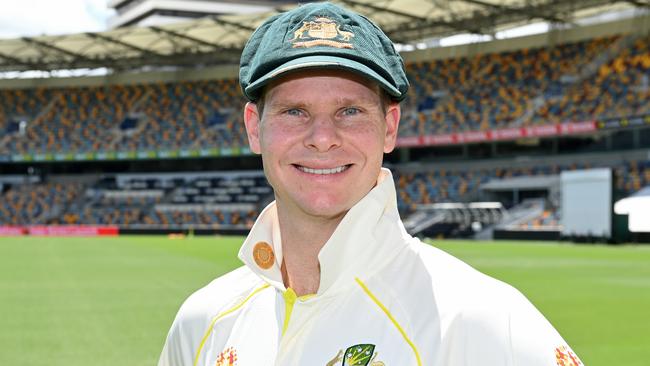
Cricket
Don't miss out on the headlines from Cricket. Followed categories will be added to My News.
Steve Smith dropped a catch in Adelaide. It was a surprising moment because Smith does not make a habit of it in Test cricket. In fact Smith has proven himself to be one of the greatest slips catchers in the game.
In terms of catches taken per match only Bob Simpson has a better record and there was none finer in the cordon than the former captain and coach who it was said would pluck passing flies as a trick to impress mates while still at school.
Smith has taken 131 catches which ranks him in the top 20 of all time, but he has played only 79 matches when every single person above him has played a 100 or more.
Smith takes 1.66 catches per match, Simpson with 1.77 is the only person among the top 50 to pouch them more frequently.
Catch every moment of The Ashes live and ad-break free during play on Kayo. New to Kayo? Try 14-days free now.
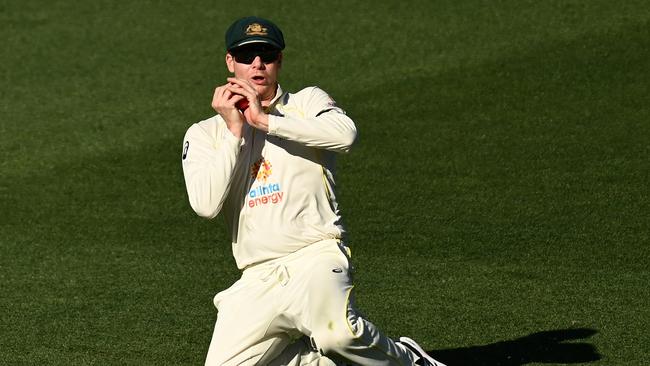
He has, as is often noticed, big hands which are presumably important but not essential — his partner David Warner has small hands.
The key, apart from practice and preternatural ability, is soft hands.
Rahul Dravid had them, so too Mark Taylor and Mark Waugh. Jonty Rhodes, possibly the best fielder of all time, often said he was not suited to the cordon because he had hard hands.
Graham Gooch nominated Mark Waugh as the best slipper of all time and believed it was because of his gentle grip.
“The trick to being a successful slip fielder is to ride the ball. The hands mustn‘t reach out for the ball as it comes towards you,“ Gooch said.
“That would put you on a collision course with the ball which is often what happens when a player drops a catch.
“With soft hands you take the sting out of the catch. When Mark Waugh dives to his left or right to take a catch he often gives the appearance of taking the ball behind him.”
Smith is aggressive in his attack on the ball, but has the ability to cradle it like it was an injured bird when it does find its way into his palms.
When he first came into the game as a bit of a bowler who batted a bit it was his outfield catching that told you there was something special about him.

Smith caught David Hussey on the boundary in an early BBL game by leaping high into the air and pulling down the passing ball between his index finger and thumb. The degree of difficulty further raised by the fact he had to balance inside the boundary rope on landing like a man (not) on a wire.
He has, as is often demonstrated, the ability to anticipate a point in space where the ball will be in and intercept it – often while horizontal – at the perfect moment.
There have been so many over the years, he appeared to transport himself from a floating second slip to gully to grab Rohit Sharma at the SCG one year, another time he ran from slip to leg slip where he stuck out an arm to catch Pakistan’s Fawad Alam off the bowling of Xavier Doherty in 2014.
That move forced umpires and commentators to dive for the rule books. Smith anticipated line and length before the ball landed, took a stab at the shot that would be played and was there when it did. Surely that wasn’t fair.
The rules state that a fielder must not make “any significant movement … after the ball comes into play” and for “close fielders anything other than minor adjustments to stance position … is significant”.
Smith’s catch was however deemed fair because there was a subclause that allowed movement “As long as the movement of a close catching fielder is in response to the striker’s actions”.
He has not spoken at length about catching, but when he has he says balance is the key and that he chooses to watch the ball all the way from the bowlers hands “because that is what you have to catch”.
Some slippers watch the back of the batsman’s blade instead.
Smith said that he was told early in his career that 50 per cent of your time in cricket is spent in the field so it is best to work on it.
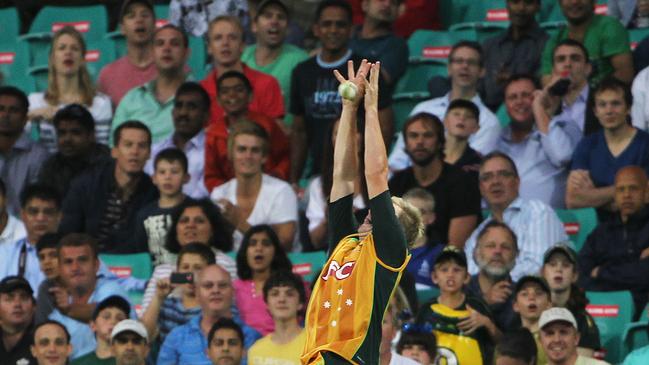
The Australian will come a step or two forward when training to put his reaction times under more pressure than they’d be in a game.
Simpson was a hungry fielder, always looking for opportunities. Once he asked the third slip if he’d mind swapping with him in first as he felt the ball was more likely to go there. He did and it did.
“The best players have always been mentally aggressive whether they were batting, bowling or fielding,” he wrote. “When I fielded at slip I willed every ball to come at me. Every one.”
Ray Robinson, writing in On Top Down Under, revealed that Simpson’s skills had benefits on and off the field.
“In two of a human’s five senses, sight and touch, Simpson is exceptionally gifted. Chances his hands reach go down only in history. A lizard catching a passing fly is scarcely more unerring. There are no flies on Bob either; he does not let them land.
“The average man can only brush at an annoying fly. Bob catches them in mid-air with either right or left hand. He began it as a boy, catching flies to amuse schoolmates who couldn’t; he did not imagine that such reflexes would make him an international cricket star.”
England’s catching has been so poor thus far this series that there is no need to issue the traditional warning about keeping their hands off our flies, but it would be churlish to bring that up in an article celebrating Smith’s achievements so we’ll stop this right now.
WHY SMITH WILL BE BACK CAPTAINING BEFORE YOU KNOW IT
—Ben Horne
Steve Smith’s return to captaincy could potentially be extended to white ball cricket as the threat of surgery hangs over Aaron Finch.
Australia’s World Cup-winning skipper is hoping he can hold off on going under the knife for further work on the same knee he had operated on last year, at least until after the tour of Pakistan in March, when he might get a break in the schedule.
However, with nine white ball matches to lead against New Zealand and Sri Lanka in February, and then three ODIs and a T20 in Pakistan in March — it will be a big ask for Finch to get through all those internationals if his knee gets sore, especially given he still has a Big Bash campaign to complete first.
Smith’s performance as Test captain filling in for Pat Cummins in Adelaide, and the largely warm public reception he received, will make the champion batsman a prime candidate to take the reins if Finch also needed to be deputised.
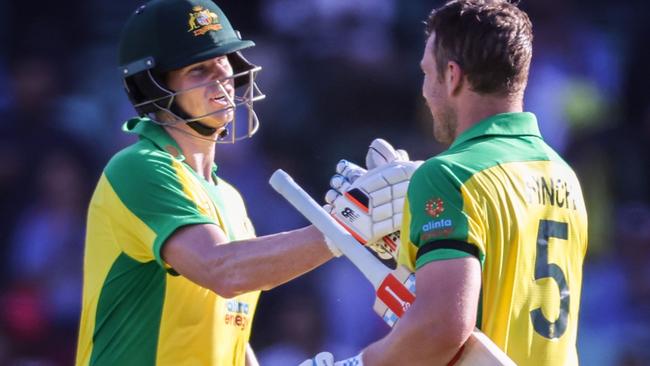
Not just because Smith proved a cool and assured head under pressure, but the controversy surrounding his return as captain following Sandpapergate barely caused a ripple.
Cummins himself would of course be an obvious stand-in for Finch, but the fast bowler has made it clear captaining the Test team is enough of a burden to carry on his shoulders.
“I think it’s too much to ask, certainly of me. I’d love to just concentrate on Test cricket,” Cummins said when appointed Test captain.
Finch’s knee troubles highlight his bravery to play through the pain barrier to lead Australia to glory at the World Cup, but admits he is destined for further surgery before he defends the T20 crown at home late next year.
“We pushed it pretty hard with the rehab and the timeline to be fit for the World Cup,” Finch told Gerard Whateley on SEN ahead of his BBL return for the Renegades.
“But it’s well worth it in hindsight, to go through all the pain and monotony of the rehab to win the World Cup.
“I had a scan when I returned home and David Young (surgeon) who did a wonderful job with my knee surgery originally said he’d like to do a little bit more on it just to clean it up and realign a few things and make sure it’s all on track long-term.
“I just don’t have time at the moment and being 35, the cricket seasons can pass pretty quickly before you know it.
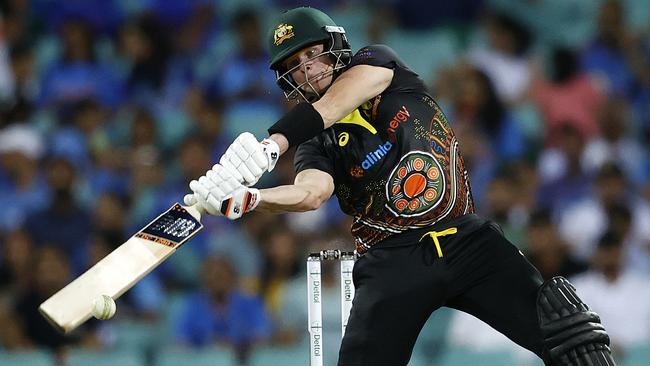
“I’ve taken this time off (over the past few weeks) to get enough rehab into it and hopefully get through the season and be able to get through to the end of the Pakistan series. Depending on what happens with the IPL auction, there might be some time after the Pakistan series.”
Finch is far from done as Australian captain, in fact Cricket Australia bosses have endorsed him to not only lead next year’s T20 World Cup defence, but the next 50-over World Cup in 2023 as well.
“I’ll try and tick off my rehab markers and make sure I’m in as good a spot as I can be to get through all those series in between,” said Finch on SEN.
According to the skipper and dual World Cup winning opener, his knee would flare up at the World Cup mostly during mix-ups running between the wickets when there’d be sudden stop and starts.
Finch was on pain killers and anti-inflammatories to get through the World Cup.
“I wasn’t in the best shape. It wasn’t a rushed rehab, but it was all crammed in really tight,” he said.
Smith made 93, caught superbly and rotated his bowlers well in Australia’s second test win over England in Adelaide, and as much as he loved doing the job again, knows his job is to play a support role.
“I enjoyed it. It brought back some old memories in a way and I had fun out there,” said Smith.
“But it’s Patty’s team and I’m the vice-captain and I’ll help him any way I can.”
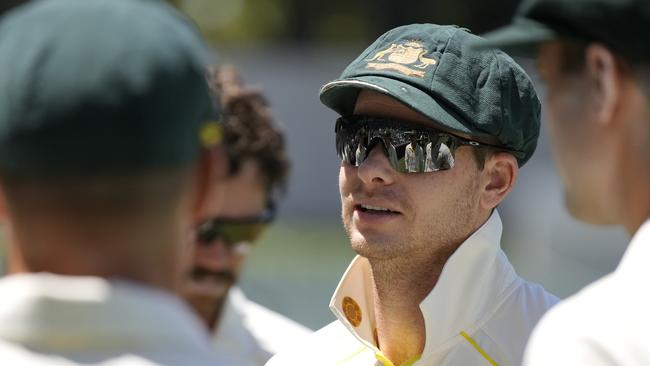
Crash: Australia’s great Smith fears prove unfounded
— Robert Craddock
Pat Cummins’ shock withdrawal from the Adelaide Test could have rocked Australia’s summer — instead it became an early Christmas present.
Cummins will return to a team which suddenly seems older, wiser, more battle-hardened and with more options than when he left — and he’s only been gone for five days!
That’s what a magnificent five day Test win can do for you.
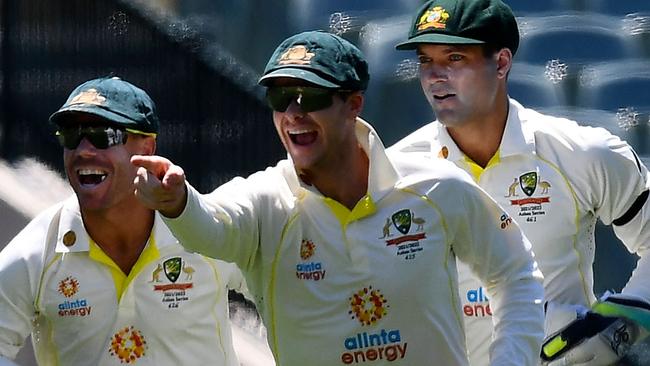
To see Jos Buttler dig in for four hours after being a man with a thousand yard stare when he twice dropped Marnus Labuschagne early in the game could only have shown youngsters like Cameron Green what true Test match cricket is all about.
But that’s not the biggest advance.
Secretly many senior Australian officials had been fretting big time about the day Steve Smith captained Australia again and, even though they endorsed him as vice-captain after much debate, privately hoped he would never wear the captain’s blazer again.
They feared a hurricane force of negative publicity would accompany his promotion to the top job and were pleasantly surprised when it was nothing more than a light zephyr.
Suddenly a boil which has been looking red and tender for three years has been lanced in this wonderful at times crazy Test match.

The elephant everyone was trying not to look at in the corner of the room wandered quietly out of the house without ransacking the furniture on the way, leaving Australia’s house very much in order.
Smith will probably captain Australia again some day and Australia does not have to stress about the moment because the second time round the opposition won’t be as rowdy as the first — and that wasn’t anywhere near as rowdy as we expected.
Cummins’ Covid-enforced game day withdrawal created chaos at the time but in retrospect we can confirm the timing was accidentally perfect.
Had Smith had a conventional elevation to the captaincy and it was announced, say, six days before the Test, there would have been a deluge of talkback callers declaring “he cheated once with the ball tampering scandal – he cannot be allowed back’’ plus angry online polls.
The dangerous beast that is social media feedback would have had the time to spiral out of control but Smith was announced captain just five hours before the Test.
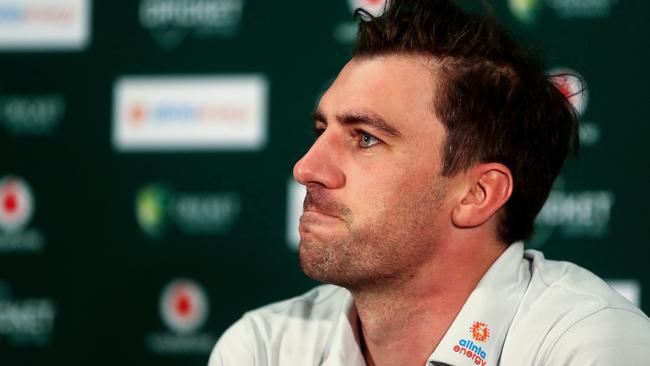
It all happened so quickly the angry masses – and they are still out there – didn’t really have the time to marshall the forces of discontent.
And Australia were in a such a numb state after Cummins withdrawal there was a sense that his appointment was a nerve settler rather than a pot stirrer. Smith was almost doing Australia a favour rather than the opposite.
Of course there are still plenty who are turned off by Smith’s appointment but many observers (myself included) thought the backlash would be more intense.
Adelaide was the perfect venue for him to return because it is the most empathetic, sympathetic crowd in Australia and he was given a significantly warm ovation.
Smith captained the team strongly, leading as he so often did by example with a rousing 93 in the first innings.
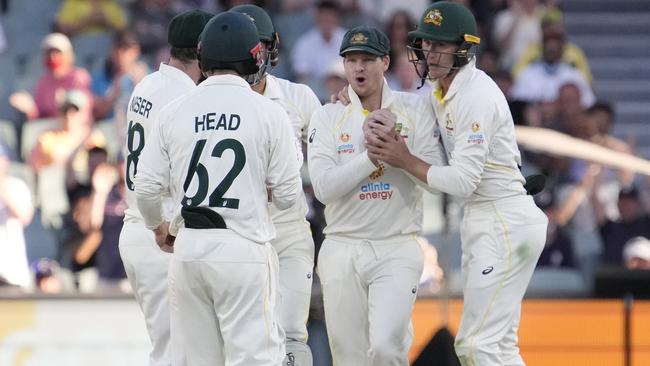
In the second innings he did look tired and could have been out three times making six.
Greg Chappell has been one of Smith’s biggest supporters but he has a theory that Smith is best suited to not being captain because the sleepless nights and general pressures of Test cricket in general take so much out of him.
His averages per innings of a Test are 87 when Australia bats first, then 59, 47 and 30 in the next three innings.
Australia is comforted by the thought Cummins should be back for good but the team grew in his absence with Jhye Richardson confirming the suspicion he will be the leader of the next generation of pace aces.
Mitchell Starc rose to the challenge of spearheading the attack and Michael Neser got a cherished baggy green that Santa Claus will find impossible to upstage on Saturday.
The euphoric moment when Neser took his first Test wicket could only help to improve team unity as the team rejoiced as if it had won the Ashes.
More Coverage
Originally published as Ashes 2021: Steve Smith’s captaincy return may not be the only one this summer




